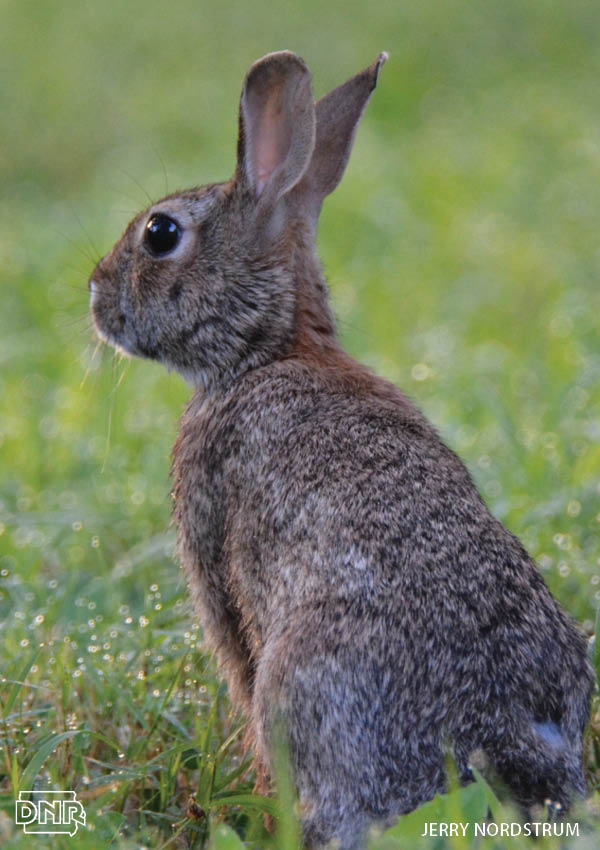Why Do Baby Wild Rabbits Have White Strips on There Heads
Rabbits are a common pet, pest and prey, only how much practice you really know well-nigh them? Check out the facts below to see why bunnies are important in Iowa and around the world.
 Spring for Joy
Spring for Joy
When rabbits are happy or excited, they leap into the air, twist and kick their feet. This move is called a binky, and can be observed in both wild and domestic rabbits. Other signs of happiness in rabbits include a gentle teeth-grinding analogous to purring, marking by rubbing odour glands under their chins on things, social grooming and flopping onto one side. Rabbits are capable of making other vocalizations, only tend not to because the noise attracts predators.
Not a Rodent
Reverse to popular conventionalities, rabbits are not rodents. They are members of the lagomorph family, whose other members include pikas and hares. Iowa has i rabbit species, the eastern cottontail, and i hare species, the white-tailed jackrabbit, which tin occasionally exist seen across the northern half of Iowa. Rabbits differ from hares in that their babies are born blind and hairless, whereas infant hares take fur and functional vision. Dissimilar rodents, these lagomorphs can only breathe through their noses and are exclusively herbivorous.
Worldwide Warrens and an Aussie Oops
Today, rabbit species are plant on every continent besides Antarctica, and over half of all the rabbits in the world live in North America. However, rabbits are non native to Australia, merely were introduced in the belatedly xviiithursday century past European immigrants for hunting and to make the settlers experience more at home. The species introduced was the European rabbit, which unlike Iowa'southward eastern cottontails, tends to alive in social colonies, or warrens. Less than a century after their introduction, these European rabbits were recognized equally a significant problem—Australia did non have abundant native predators to reduce rabbit populations, and this – combined with their astonishing reproduction rate – meant rabbits were outcompeting native herbivores and decimating crops. The government and citizens tried various methods of extermination with little lasting success. The most famous of these attempts was a biological control measure in which myxoma virus was released into the rabbit population in 1950, causing the population to drop from about 600 million to nigh 100 million. Unfortunately, resistant rabbits survived, and by the early on 1990s the population had rebounded to betwixt 200 and 300 one thousand thousand.
Evasive Measures
As a casualty animal, rabbits pay a lot of attention to their surroundings to avoid predators. 1 thing that helps is their wide field of vision, which is just interrupted by an approximately x-degree bullheaded spot in forepart of their face. If a predator is spotted, social species like European rabbits alert the whole colony by thumping their hind legs on the footing. Individual cottontails but hold still and try to avoid detection, running away equally a terminal resort. When pursued, these rabbits run at speeds upwards to 18 mph in a zig-zag circle to brand it harder for larger predators (who can't turn as easily) to catch them, covering upwards to xv feet in a single bound. If information technology is caught, the rabbit can boot and shed large amounts of fur to try and wriggle out of a predator's grasp. Rabbits also tend to forage at dawn and dusk, when it's hardest for predators to spot them.
Tough Teeth
A rabbit's front teeth, similar their nails, never cease growing over the course of their life. This makes it possible for them to continually eat tough foods like grasses, which slowly wearable down the teeth over time. If a rabbit does not eat tough food for an extended period, the teeth may become overgrown and cause farther health complications. Because grasses are so tough and hard to digest, rabbits will sometimes swallow their droppings to process fabric twice and extract more calories. Rabbits are incapable of airsickness, which probably helps. The dung itself is excellent fertilizer, and the high-nitrogen urine tin help lemon trees exist more than productive.
Grow Upward Fast
Rabbits are known the world over for their impressive reproductive abilities. A rabbit is sexually mature at just iv months, and females tin produce a litter of babies, called kits or kittens, in 30 days. A mother rabbit is fertile once again within 24 hours of giving birth, and she may take multiple litters over the course of one breeding flavour. At that place is a high risk of reproductive cancers in un-spayed domestic females.
(Un)abandoned Babies
If yous happen to find a nest of babe bunnies and don't see the mother nearby, that doesn't mean they've been abandoned. Mother rabbits only visit their young a few times a day and avoid doing so in daylight to avoid showing predators where their babies are. If y'all uncover a nest accidentally, supercede the dried grass and fur that was covering it and leave the area. The mother will return and care for the young at that place or motility them to another (undiscovered) location. Practice non endeavor to care for the babies yourself. They have a very low survival charge per unit even with trained wild animals rehabilitators, and some natural selection is to exist expected.
Rabbit Season, Duck Flavour
Don't worry almost dithering effectually similar Elmer, it's both! For 2016, both small game and the special teal-simply hunting seasons are scheduled to get-go on September 3. Be certain your license is up-to-date before heading out, and refer to the 2016-2017 hunting and trapping regulations for specific dates and more information. If you decide to get out for rabbits, DNR wildlife technician Jim Coffey says to retrieve they run in big circles when chased, which makes them fun to hunt with dogs.
For more than, check out our Iowa Wildlife board on Pinterest.
Source: https://www.iowadnr.gov/About-DNR/DNR-News-Releases/ArticleID/979/8-cool-things-you-should-know-about-rabbits
0 Response to "Why Do Baby Wild Rabbits Have White Strips on There Heads"
Post a Comment